Picture this: your website gets a hundred visits today, with some people downloading your free guide and clicking through your pricing page. So, you get your hopes up about gaining several new customers, but by next week, there’s no progress at all.
Sounds familiar?
The truth is, if there’s no follow-up and tracking, even the most promising leads can slip away.
That’s why you need lead management — a structured way to capture interest and turn curiosity into customers.
Keep reading to see why lead management matters and how to build a process that works!

In this article:
What is lead management?
Lead management is the process of capturing and tracking potential customers (leads) through the sales journey, from their first interest to final purchase.
A lead can be an individual or a business interested in purchasing your product or service.
For example, imagine someone visits your website and fills out a form to receive a free ebook. This person is a lead, so you:
- Capture their info (name, email),
- Track their actions (opening your email, clicking a link),
- Evaluate their interest (they requested a demo),
- Assign them a sales rep, and
- Follow up with a personalized email.
Hopefully, the lead eventually buys your product/service, officially turning into a customer.
Why is lead management important?
Lead management is important because it offers several notable benefits, such as:
- Identifying best-performing marketing channels — Learn where your best leads are coming from so that you can invest more in what works.
- Prioritizing high-quality leads — Use lead scoring to help your team focus on the people most likely to buy.
- Boosting sales conversion rates — Track and nurture leads properly to ensure more of them become paying customers.
- Greater sales team efficiency — Reduce guesswork and manual efforts to help reps work faster and smarter.
- Obtaining data for future strategies — Get insights into what’s working and what’s not to plan better campaigns.
In contrast, if you fail to manage leads effectively, you’ll likely miss sales opportunities and waste team effort and resources.

The core principles of lead management
A strong lead management system is tied to several principles for tracking leads and guiding them toward becoming loyal customers.
Let’s break down those core principles.
#1 Collection and analysis of quality data
To yield results, lead management must rely on accurate, relevant data. So, instead of just collecting names and email addresses, make sure to get useful context, such as:
- Where the lead came from,
- What industry they’re in,
- How they interacted with your content, and
- What problems they’re trying to solve.
The better your data, the higher your chances of converting that lead.
Plus, analyzing data helps you spot patterns — e.g., which campaigns bring in serious buyers or which industries/job titles are more likely to buy. With that insight, you can optimize your entire sales funnel.
#2 Knowing your ideal customer
You need to know who you’re trying to attract, so the best thing to do is create a clear Ideal Customer Profile (ICP).
This is based on real data, such as:
- Job role,
- Industry,
- Company size,
- Goals and challenges, and
- Buying behavior.
Build neat boards for ICPs in Plaky
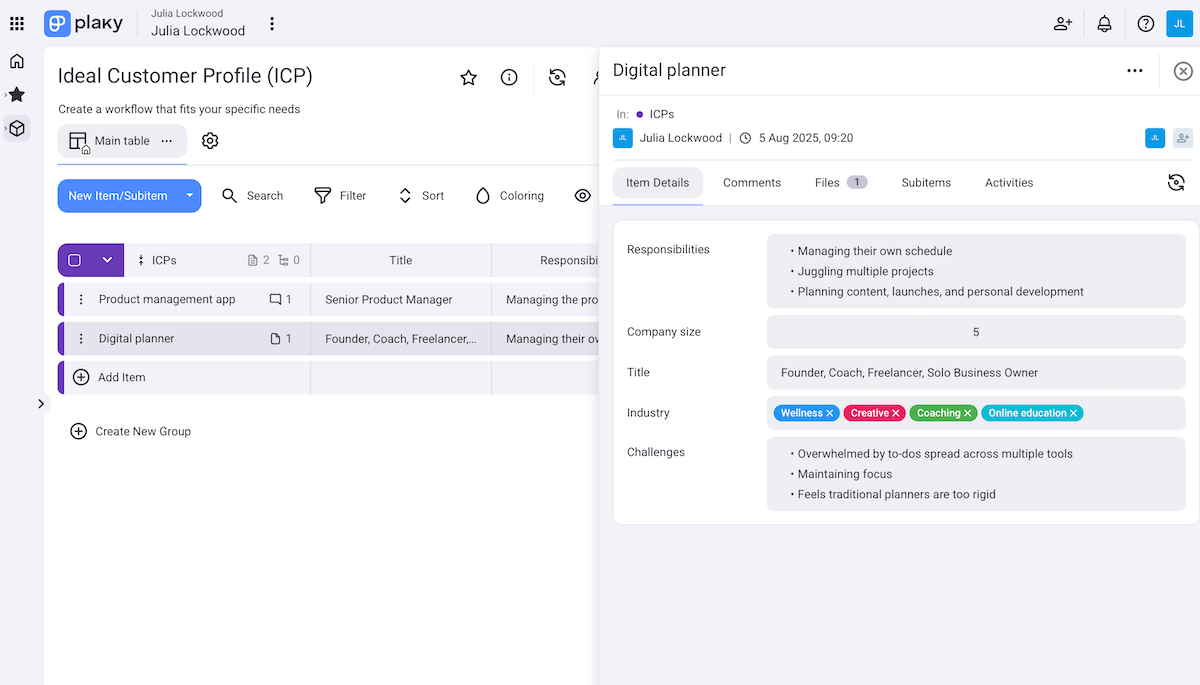
Considering your ICP sharpens your marketing and sales messages. You can directly address your ideal buyer’s pain points and present your product in the best light, offering a solution.
Ultimately, this sets the foundation for efficient lead qualification and better ROI across the board.
#3 Lead scoring and qualification
Not all leads are equal, so treating them all the same can quickly result in wasted time and lost sales.
That’s where lead scoring comes in — assigning value to each lead depending on how closely they match your ICP and how engaged they are. The higher the score, the more sales-ready the lead likely is.
Once evaluated, leads are typically categorized as:
- Marketing qualified leads (MQLs) — These leads have shown interest and match your target audience, but they aren’t quite ready to buy.
- Sales qualified leads (SQLs) — These leads are more sales-ready based on their behavior and interest, so the sales team should contact them.
Understanding this difference helps marketing and sales teams collaborate more smoothly since the leads are handed off at the right moment.
💡 Plaky Pro Tip
If you’d like to read more about project management in marketing, we highly recommend checking out the following guide:
#4 Long-term planning and nurturing
The reality is most leads won’t buy immediately. Many need more information and trust before making a decision, which makes lead nurturing essential.
Our contributor, Ryan McCallister, the CEO and founder of a mortgage company, supports this view:

“I create an informative rhythm that keeps cold leads focused — localized walkthroughs, brief updates on property values in particular cities, and lender program windows that have a time frame of 30-60 days.
I do not consider long-term leads as inactive. I monitor their progress throughout the process and provide them with the next definite steps that will suit them. That forms a steadier, although slower route of conversion. The advance planning will enable me to seal some deals that others forget.”
So, consistency and relevance are crucial here. By sending the right message at the right time, you market your product without being pushy. This way, you’re building relationships, not just chasing deals.
Lead management process: a 5-step guide
We can look at lead management as a process consisting of several steps. They may vary based on your needs or preferences, but generally speaking, these are the 5 key steps.
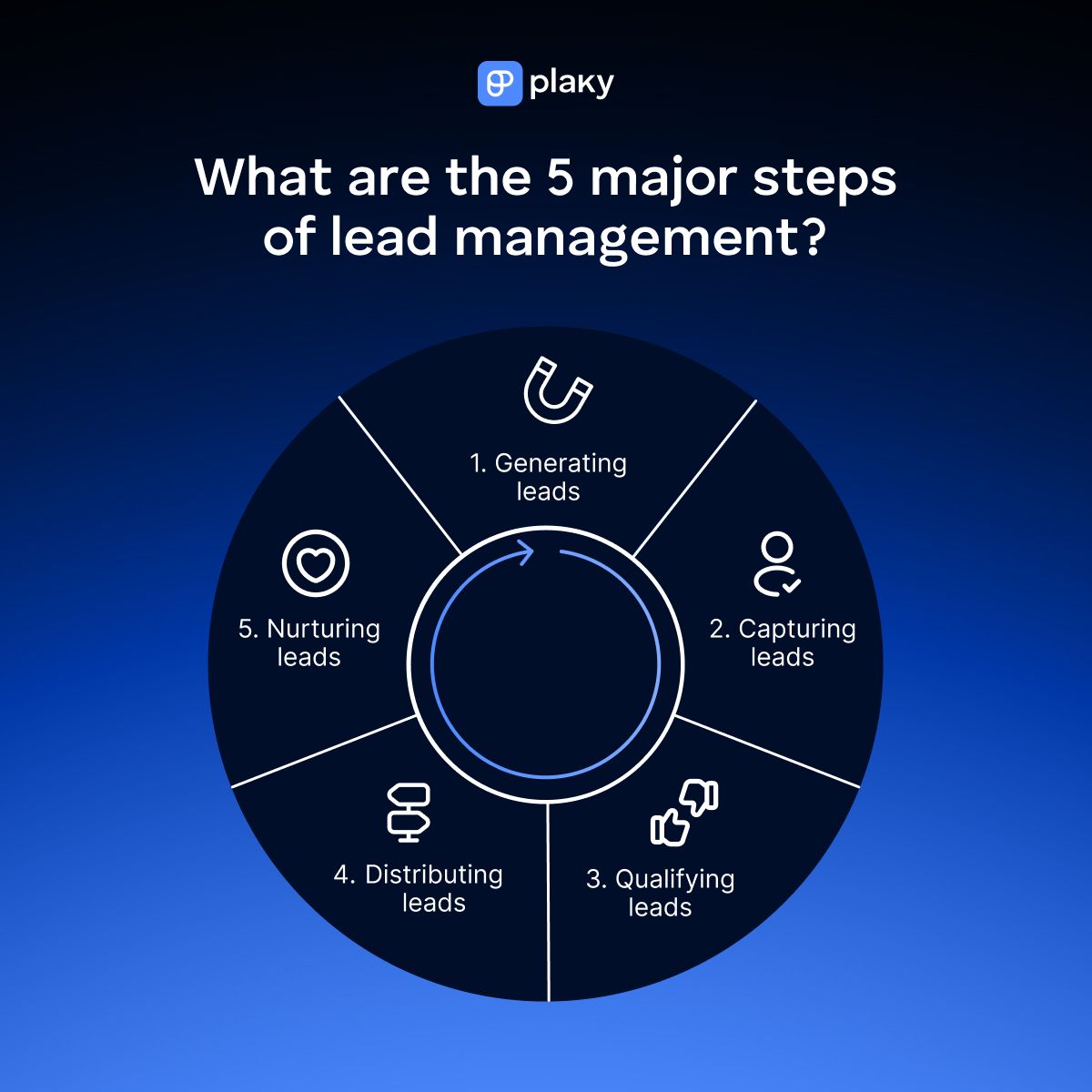
#1 Generate leads
You start by identifying and attracting the right people to your business. Lead generation can happen through:
- Blog content,
- Social media,
- Paid ads,
- Cold calling,
- Email marketing, and more.
The aim is to spark interest and draw potential customers to your brand. It’s better to focus on quality over quantity here — you want people who actually need what you offer.
Brainstorm marketing ideas in Plaky
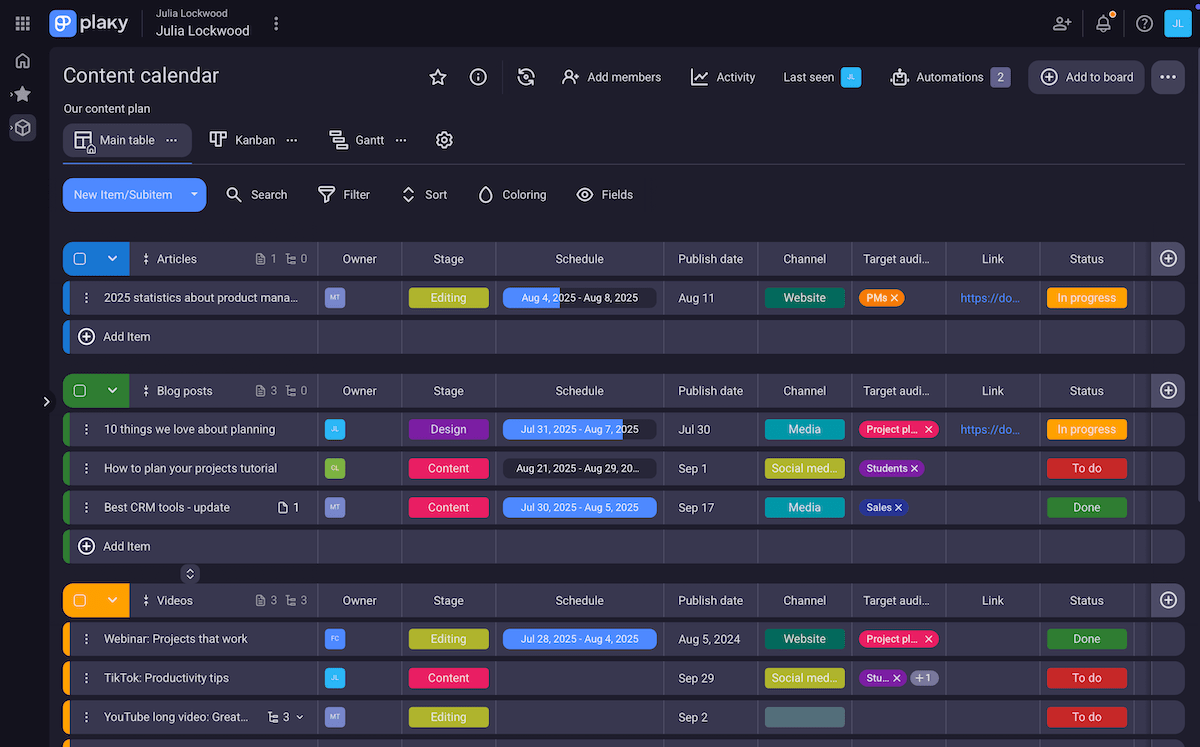
#2 Capture leads
Once someone shows interest in your service or product, you need to collect their information. This often happens through:
- Forms,
- Chatbots,
- Newsletter signups,
- Landing pages, etc.
At this point, it’s important to ask for just enough information (name, email, and a few qualifying questions) to keep the process smooth.
Remember, this is still a rather early part of the process — the lead is yet to become a customer. So, the point is to keep them engaged and open to future marketing efforts.
#3 Qualify leads
Not every lead is ready (or even suitable) for your product or service. So, this step is about filtering them.
Consider questions such as:
- Does this lead have sufficient budget?
- Are they a decision maker?
- Is there a real need your product solves?
The purpose isn’t to reject leads too early, but to understand where they are in their buying journey and how to engage them appropriately.
And while the previously mentioned marketing/sales qualified leads distinction is quite widespread, many teams use other qualification stages to create a more tailored lead pipeline. For example, there are less formal but often used categories, such as:
- Cold leads — low engagement, not ready,
- Warm leads — some interest or interaction, and
- Hot leads — actively looking to buy soon.
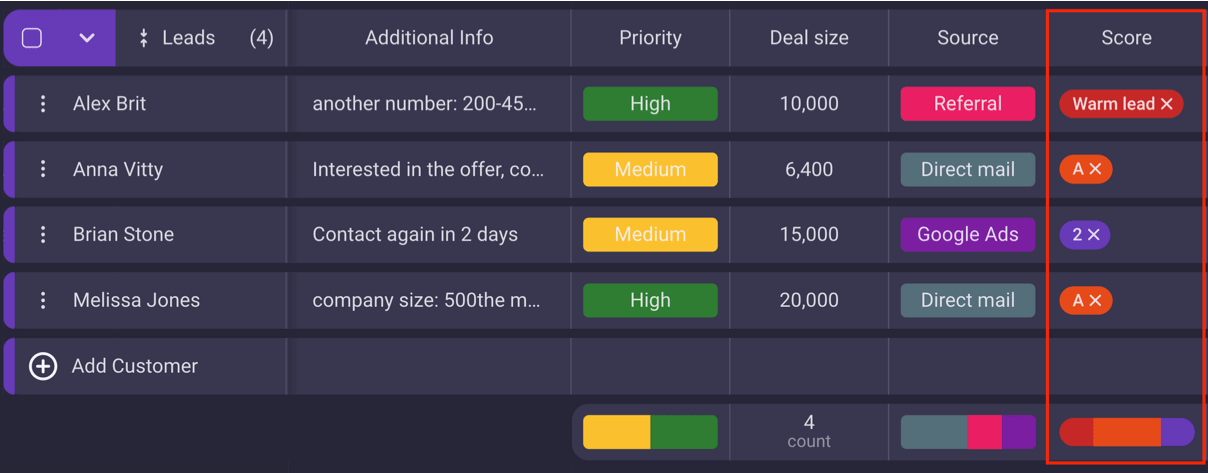
#4 Distribute leads
The next step is getting the lead into the right hands. This means assigning leads to the appropriate teams or sales reps based on factors such as product interest, region, or lead score.
Quick and strategic lead distribution boosts your chances of making contact while interest is still high.
Here’s what Vincent Burruano — a sales professional with over 30 years of experience — had to say on the subject:

“The most important element of a comprehensive lead strategy is to ensure the leads you generate are quickly and appropriately pursued. Too often leads go stale because it takes too long to route them to the correct sales professional, or because your sales team is not engaging the leads with a sense of urgency these leads deserve.”
#5 Nurture leads
We must emphasize again that leads often aren’t ready to buy right away — and that’s okay. Instead of pushing for a quick sale, you should strive to provide consistent, relevant value until the lead is ready to make a decision.
So, lead nurturing is about keeping the conversation going through targeted content, such as:
- Email marketing,
- Remarketing ads,
- Blog posts,
- Personal outreach, etc.
In addition, you should continue to collect fresh data and monitor lead behavior. If you understand what your leads care about, you can guide them forward naturally and respectfully.
This is in line with the practices of another contributor of ours, Amanda Sexton, a marketing professional with over 15 years of experience:

“In order to excel, marketers must identify where a lead is in their decision-making process and deliver relevant, timely content that moves them closer to a purchasing decision. This approach necessitates a blend of data-driven insights and empathetic communication. Remember, it’s not just about managing leads; it’s about understanding their needs and building relationships.”
Bonus step: Convert and retain leads
This is a bonus step because traditional lead management tends to focus on moving leads to the point of conversion. In other words, many treat this as a part of customer relationship management (CRM) or life cycle marketing.
Here’s how to use Plaky for CRM
That said, we included this step because it completes the journey. After all, what’s the point of attracting and nurturing leads if we don’t think about what happens after they’ve become customers?
So, to turn first-time buyers into loyal customers, it’s crucial to:
- Follow up after a purchase,
- Offer onboarding support, and
- Keep tracking progress and relevant KPIs.
Also, don’t forget to continuously analyze and refine your funnel. This way, you can adapt to changing customer needs, ultimately making smarter, data-backed decisions.

Popular lead management tools and techniques
Sales professionals rely on different lead management tools and techniques, i.e., software and strategies that support their work. Some of the most popular examples are:
- CRM software — Store lead info and manage pipelines in a centralized platform, keeping sales and marketing teams aligned and organized.
- Marketing automation platforms — Automate emails and workflows to keep leads engaged without manual work.
- Email tracking and analytics — Track if leads open your emails and click links to assess their interest level and timing for follow-ups.
- Web forms and landing pages — Capture lead info when someone signs up for a freebie or a demo, feeding data directly into your system.
- Personalization — Tailor content and outreach based on a lead’s preferences and behavior to increase trust and conversions.
- Lead segmentation — Group leads based on shared traits (e.g., industry, lead score) to enable more personalized marketing and sales messaging.
- Lead distribution rules — Automatically assign leads to the right team member based on certain criteria (e.g., region, product interest) to speed up response time.
Ryan McCallister acknowledges these are highly useful and offers a helpful example:

“I am lining up my pipeline in automation and customization. I use CRMs that enable me to track behavior, automate outreach, and personalize messages such that it never sounds robotic. I can insert brief video messages within follow-ups in one system so that buyers actually see a face, not a name. All messages are associated with what the buyer is seeking and not general information.”
💡 Plaky Pro Tip
Want to check out some handy CRM tools for small businesses? We’ve reviewed a bunch, stating all their pros and cons. Read our reviews here:
Simplify lead management with Plaky
Lead management tends to be a complex process, blossoming into CRM once your leads become customers. So, the smartest thing you can do is manage all operations in one centralized place.
That’s where Plaky comes in, offering simple yet powerful features that let it adapt to teams of various sizes with different roles.
To begin with, Plaky’s hierarchy ensures clear organization. Here’s how you can use it:
- Spaces — Use the highest layer to separate key business areas or teams for better focus and clarity.
- Boards — Within each space, build boards for specific workflows (e.g., lead generation campaigns, ad performance tracking), reflecting the stages or goals of your process.
- Items — Create items within boards to represent individual leads, campaigns, and other units of work to monitor progress with ease.
- Subitems — Break items into smaller steps to ensure visibility into every action moving the lead or project forward.
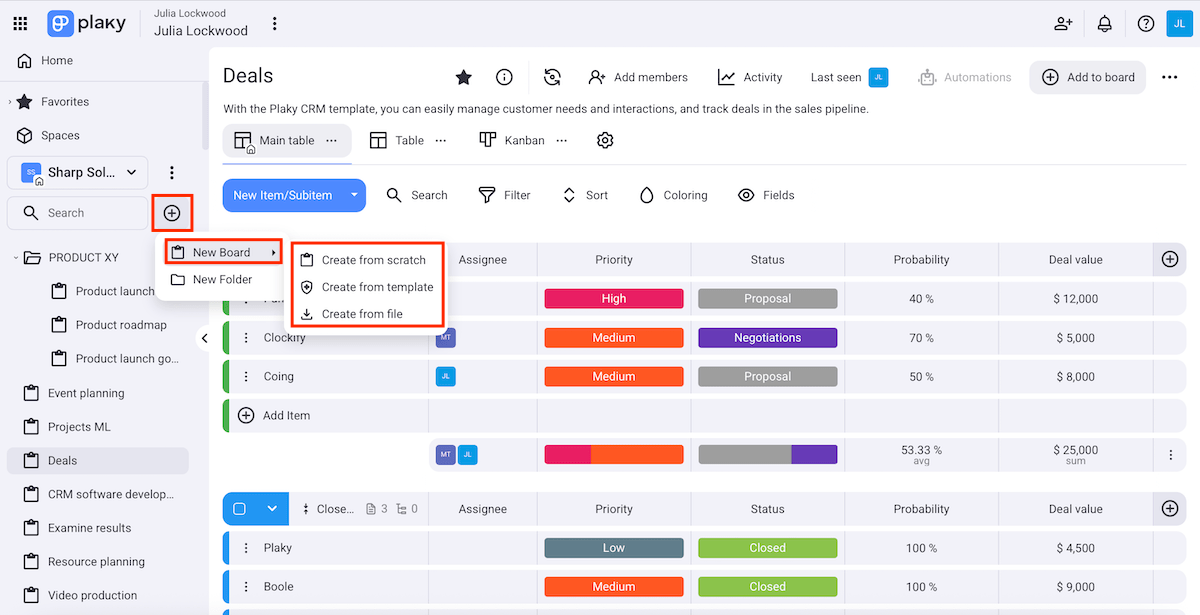
Plaky’s forte is custom fields, allowing you to add specific info to each lead and other items. For example:
- Text — Record the company name, job title, or lead notes.
- Person — Assign a lead to a specific sales rep or account manager.
- Number — Track the lead score or deal value.
- Link — Add URLs to company websites, LinkedIn profiles, and meeting recordings.
- Date — Specify the last contact date, deadline, or follow-up date.
- Status — Track lead stages and priority, and more.
Bonus tip: Use board automations! Reducing repetitive, manual work means more precision and time for meaningful tasks. For instance, you could:
- Automatically assign leads to reps based on the source,
- Change statuses when subitems are completed,
- Subscribe a manager once an item’s priority changes, and more.

Moreover, Plaky lets teams visualize the same data in different ways, boosting clarity and flexibility even more. Try these board views to see which one suits you best:
- Table view — default spreadsheet-style overview, great for sorting and filtering,
- Kanban view — visual pipeline showing stages, ideal for tracking progress and moving leads forward,
- Gantt chart view — timeline view, best for planning and monitoring follow-ups or campaign schedules, and
- Chart view — bar and pie charts, perfect for quickly comparing data like lead sources or status distribution.
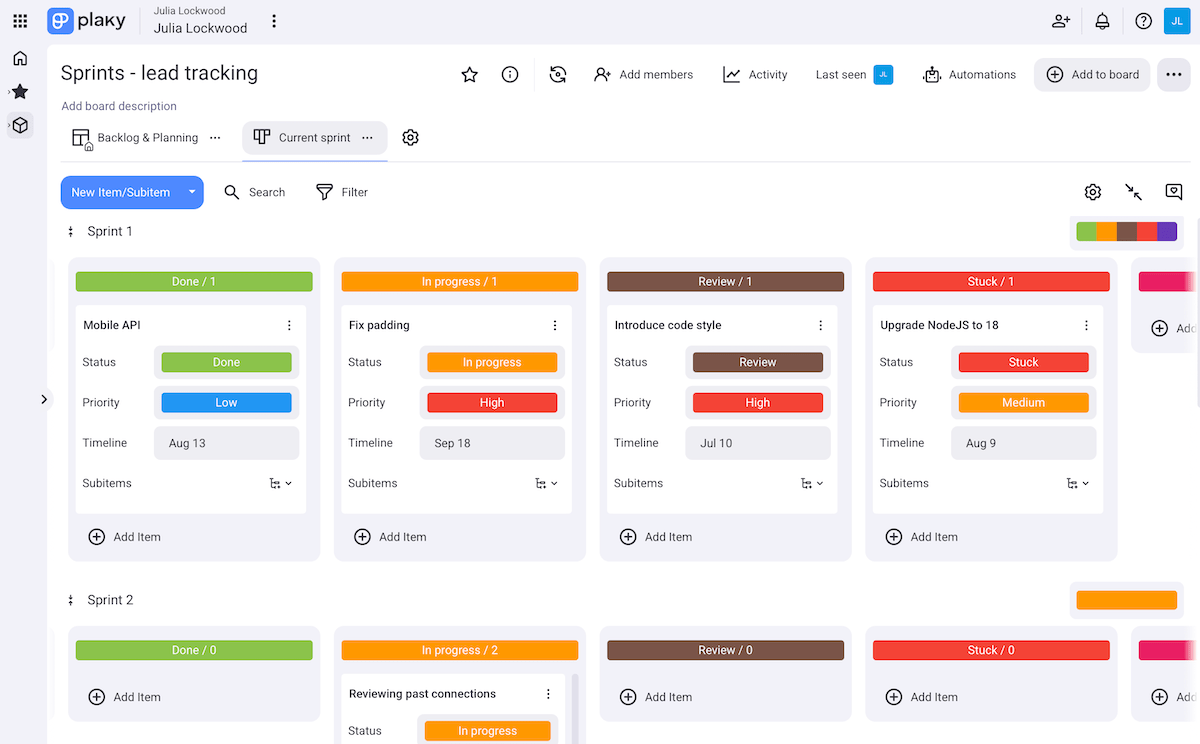
All of this encourages project collaboration, along with these features:
- Comments & @mentions — Leave comments and tag teammates to keep discussions and feedback in one place.
- Activity log — Check who did what and when for full transparency and accountability.
- File uploads — Attach proposals, contracts, screenshots, etc. so that relevant people have access when needed, depending on their user roles.
- Real-time notifications — Never worry about missing updates since Plaky alerts you about changes wherever you’re involved.
As a cherry on top, all of this comes with a user-friendly design at an affordable price.
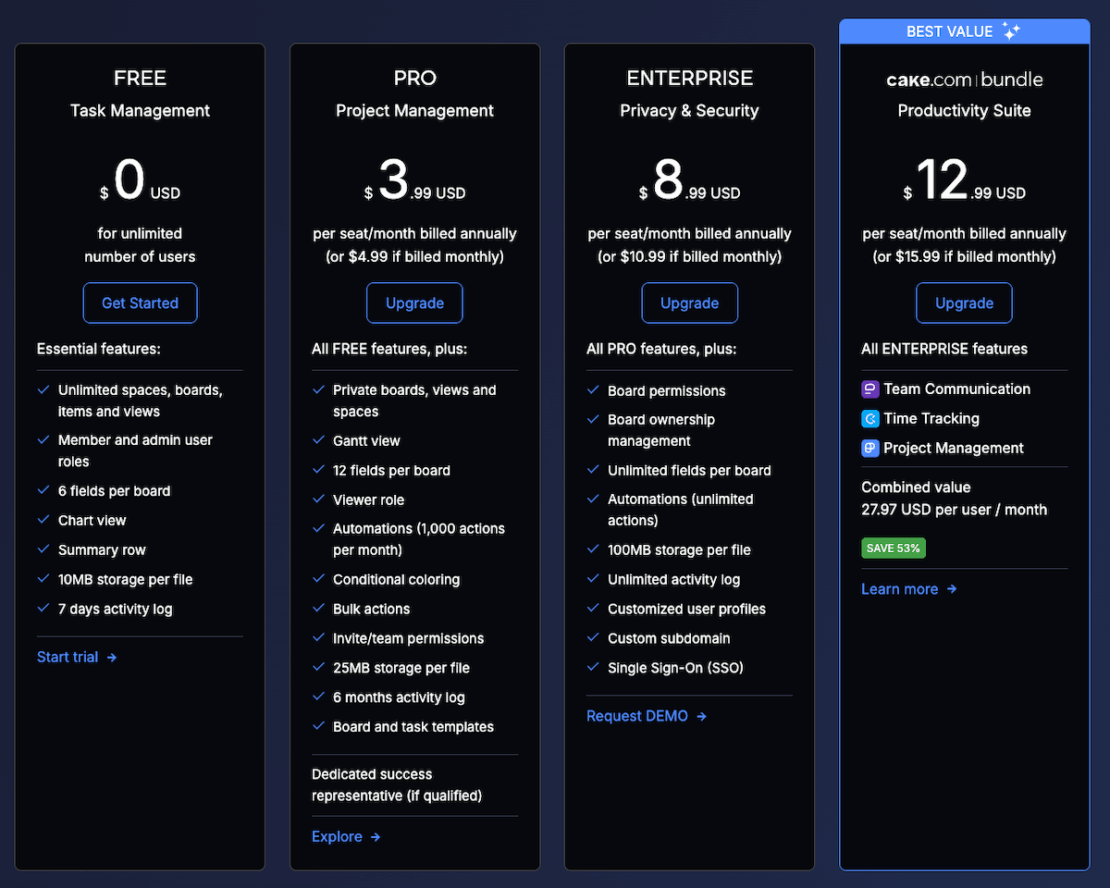
Track your sales process easily from lead to loyalty — get started with Plaky today!


